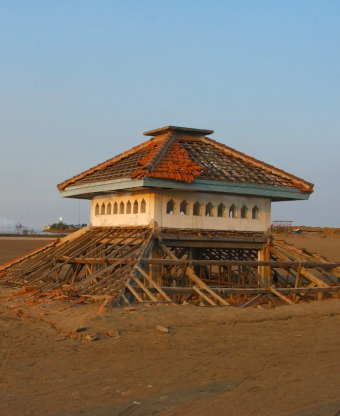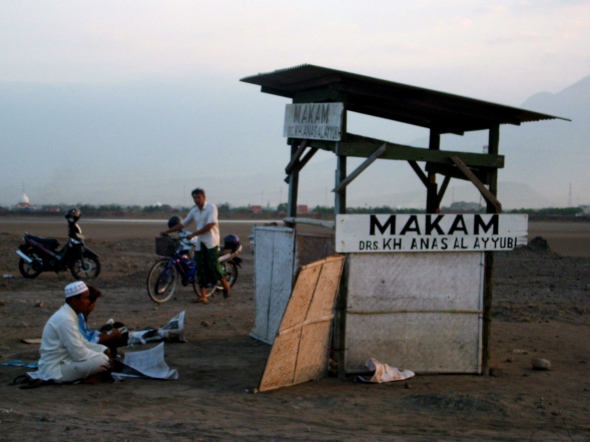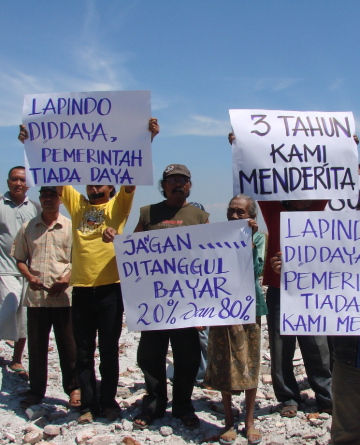Bosman Batubara
Protesters register their angerParing Waluyo Utomo |
‘My house was about 200 metres north of that mosque,’ says Cak Harto, as he points towards all that remains – the roof of a mosque poking through a vast basin of dried mud. Around it, the intense heat of the sun is slowly turning the surface of the old, caked mud into dust.
The mosque is just one of thousands of buildings submerged by the Lapindo hot mudflow in the area around Porong, located to the south of Surabaya, the provincial capital of East Java. On 29 May 2006 the disaster began with an eruption, which has continued unabated ever since, pushing about 100,000 cubic metres of mud to the surface every day. As a result, more than 12,000 families have been forced to abandon their homes. Levees stretching over 23 kilometres now enclose the disaster area to retain the accumulating pool of mud, which covers about 800 hectares of land.
The Lapindo mudflow is a unique disaster. Early on, fervent debate over what caused it gripped an international community of geoscientists, Indonesian policy makers and concerned community organisers, while a baffled public looked on. Generally stated, there are two opposing views. The first, currently supported by the bulk of scientific investigation, points to drilling activities at Banjar Panji 1 (BJP 1), a gas exploration well owned by PT Lapindo Brantas Inc, as the disaster’s trigger. This would put responsibility for damages suffered by Porong’s residents, businesses, local environment and economy on the shoulders of Lapindo. However, the company has insisted that the cause of the disaster lies with an earthquake that struck the city of Yogyakarta two days prior to the mud eruption. This would put the mudflow into the category of ‘natural disaster’, absolving Lapindo of responsibility and requiring the national government to deal with the repercussions.
In Porong, people believe that the disaster was triggered by drilling at the BJP 1 well. Often villagers will quip, ’Which came first, the eruption or the drilling?’ Or they explain, ‘We had many earthquakes before the drilling – even earthquakes of a larger scale – but there had never been a mud eruption before this.’
Years of struggle
Cak Harto (Cak is a common term of address for men in East Java) lived in the village of Jatirejo, but now he stays with his wife and two sons in a rented house in Kejapanan, a village located south of the levees. Jatirejo was one of the first villages submerged by the mudflow, and since the disaster struck he has been actively involved in several community-led movements pushing for compensation for the villagers’ losses. Currently, he is a member of the Movement to Support Presidential Regulation Number 14/2007 (GEPPRES).GEPPRES was established by a group of mudflow victims to lobby for the implementation of the regulation issued by the Indonesian government in response to the disaster.
Through article 15 of this regulation the government ordered PT Lapindo Brantas Inc to pay compensation to villagers affected by the mudflow in two instalments: a 20 per cent ‘advance’ distributed to affected households without delay, and the remaining 80 per cent distributed one month before the end of the two-year period during which a housing allowance was provided by the company. Lapindo’s housing allowance provision ceased in mid-2008 so according to this law the company should have paid compensation to villagers for homes and land lost. However, the company did not obey the order, and the Indonesian government failed to enforce it. In early September 2009, the Indonesian government attempted to apply additional pressure by issuing a new regulation known as Perpres 40/2009. Not only did this new regulation have no bite but every provision was identical to the previous one.
 |
All that remains of the mosqueBosman Batubara |
A spokesperson from PT Minarak Lapindo Jaya, a subsidiary of PT Lapindo Brantas Inc, said that the company was unable to pay the compensation stipulated in Perpres 14/2007 due to the global financial crisis. The company created its own two options for payment soon after Perpres 14/2007 was issued. First there was a scheme to provide resettlement in new homes and compensation for property paid in instalments of roughly 15 million rupiah per month minus the value of the new home. The second option offered was compensation for property lost paid in installments of roughly 15 million rupiah per month.
Members of GEPPRES refuse to sell their land under any scheme other than the one stipulated in Perpres 14/2007. GEPPRES members come from four villages (Jatirejo, Kedungbendo, Siring and Renokenongo) and as of December 2009 PT Lapindo Brantas Inc has not paid the second instalment due to the 157 land title holders among them. Needless to say, GEPPRES has good reason to keep up its struggle; members believe that at the very least, Lapindo still owes them for homes and land lost to the mud.
GEPPRES is only one of several disaster victims’ groups that have formed throughout East Java, and each has reacted differently to the schemes offered by PT Minarak Lapindo Jaya. Generally speaking, groups have fallen into one of two categories: those who accept compensation under one of the schemes and those who do not.
While GEPPRES has refused the compensation offer, a group known as the Lapindo Mud Victims (GKLL) has accepted resettlement to Kahuripan Nirwana village and compensation paid in instalments. Roughly 2000 households throughout Porong accepted this scheme but villagers claim that PT Minarak Lapindo Jaya has only provided about 500 houses so far.
Another large group with more than 3000 members which goes by the name Tim 16 Perumtas (Housing Estate 16 Team), most of whom formerly lived in the same housing estate within Kedungbendo village, chose the second scheme promising installments of 15 million rupiah per month. Another group of victims from Renokenongo are called Pagar Rekorlap or Wong Pasar (the Market People) owing to the fact that they were the last to leave the emergency evacuation area at Porong Market, initially chose instalments of 15 million per month. However the group ultimately fractured when 506 households decided to build a new village and move together to Kedung Gampil, land currently used for sugar cane cultivation.
Memory as social resistance
I asked Cak Harto, ‘Why do you tell me these stories about your village, so painfully reconstructing each detail for me?’ His response was that he hoped I would write his story, so that the world would know of the people’s daunting struggle in the face of the Lapindo disaster. He hopes to raise sympathy for what they’ve endured, as well as understanding and strength to support their fight for compensation. He admitted that he was tired after more than three years of negotiating and demonstrating. As I stood listening to him, I realised that, for Cak Harto, the power to recall events was its own form of social resistance.
As I stood listening to him, I realised that, for Cak Harto, the power to recall events was its own form of social resistance
Later that night, he drew a detailed map of his village on my notepad. ‘Right here was our fruit market,’ he said, pointing to the middle of the map. He recalled a huge fruit market where traders came in every night to sell their produce. All that remained now were empty stalls. ‘Here, there were many shops. My family used one of then as a motorbike showroom,’ he continued. Cak Harto then pointed to where he had drawn a small picture of the main gate of Jatirejo village, a command post or ‘posko’ – ‘This is where I spent most of my time talking with friends, day and night.’ As I couldn’t help but note, the gate now led to nowhere.
That night, Cak Harto took me to the gate, and we walked through it westward past many abandoned houses. The villagers abandoned their houses here because it wasn’t safe to live so close to the levee. Continuing west, we climbed the wooden stairs built by villagers so that they could climb over the levee. From the top of the levee, in the moonlit night I saw an endless expanse of mud reaching into the darkness. Just the day before, I had watched young boys playing football in the very same spot, over the hardened clay.
 |
Villagers praying in front of a makeshift marker of KH Anas Al-Ayyubi’s grave. The original was covered by the mud.Bosman Batubara |
To the west of the ‘football field’ we came to a place where the mud has buried an entire cemetery. In the daytime, many villagers come here to recite prayers. Although it is no longer visible under the mud, the villagers have erected a sign to mark the exact spot above the grave of KH Anas Al Ayyubi. Al Ayyubi was a local man and leader of the respected Islamic organisation Nahdlatul Ulama (NU). Nyai Dewi, his wife, said that the government had asked the family to relocate the cemetery somewhere outside of the levees, but they refused because they thought it would be wrong to move those who have been buried.
On a different occasion, during a nyekar ceremony held before the Muslim fasting month in 2009, I again witnessed the people of Porong using memory as a form of social resistance. Derived from sekar, a Javanese word meaning flower, nyekar is a Javanese tradition of visiting ancestors’ gravesites. Before the mudflow disaster, villagers would visit the cemeteries one or two days before the fasting began. But in recent years, since the cemetery has been swallowed by mud, villagers have only been able to observe nyekar while standing and praying on the levee above it.
Last year, villagers collectively agreed to incorporate their feelings regarding the struggle for compensation into a solemn ceremony. They tossed flowers into the noxious mud and then they threw stones at a picture of Aburizal Bakrie, one of the owners of PT Lapindo Brantas Inc and then Coordinating Minister for Social Welfare. Villagers consider him the root of their problems, since neither he nor his company have yet taken responsibility for the damage done to their lives, livelihoods, and futures. At the time of the nyekar, Aburizal was in the midst of a successful campaign to become the chairman of Golkar, Indonesia’s second largest political party. During his campaign, he personally promised to give a trillion rupiah to the party if he were elected to head it. The villagers, gripped with anger, wrote across his picture, ‘One trillion for Golkar??? What about the Lapindo victims???’
GEPPRES is still fighting for payment of the second instalment of compensation due to its members. Those who chose the resettlement scheme have learnt that the monthly instalments they are supposed to receive on the 3rd of every month rarely come on time. They have long tried following the appropriate avenues to see that their compensation is dispensed properly, but nothing seems to work. Perhaps because these formal procedures exhaust them, they have turned to another kind of social resistance, the public enactment of communal memory. In this situation of unequal power relations between victims and those responsible for just compensation, this type of resistance serves to sustain their struggle.
Bosman Batubara (http://annelis.wordpress.com) graduated from the Department of Geology at Gadjah Mada University and is currently a program officer at Lafadl Initiatives working with victims of the mudflow on a women’s economic empowerment project. He would like to thank Paring Waluyo Utomo for assistance with this article.
